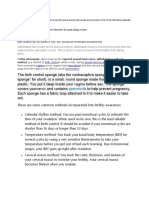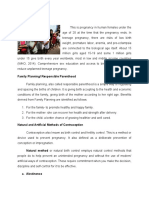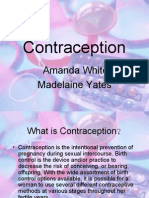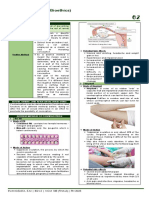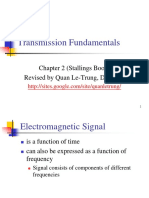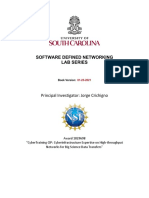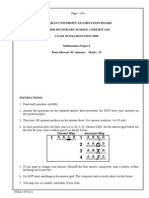Contraception (birth control) prevents pregnancy by interfering with the normal process of
ovulation, fertilization, and implantation. Every month, a woman's body begins the process that
can potentially lead to pregnancy. An egg (ovum) matures, the mucus that is secreted by the
cervix (a cylindrical-shaped organ at the lower end of the uterus) changes to be more inviting to
sperm, and the lining of the uterus grows in preparation for receiving a fertilized egg. Any
woman who wants to prevent pregnancy must use a reliable form of birth control.
Birth control (contraception) is designed to interfere with the normal process and prevent the
pregnancy that could result. There are different kinds of birth control that act at different points
in the process, from ovulation, through fertilization, to implantation. Each method has its own
side effects and risks. Some methods are more reliable than others. There are more different
types of birth control available today than ever. They can be divided into a few groups based on
how they work. These groups include:
1. Hormonal methods 7. Calender Rhythm Method
2. Barrier methods 8. Withdrawal Method
3. Spermicides 9. Basal Body Temperature (BBT)
4. Intrauterine devices Method
5. Tubal sterilization 10. Ovulation Method
6. Vasectomy
1) Hormonal Methods:
Hormonal methods of birth control use hormones to regulate or stop ovulation and prevent
pregnancy. Ovulation is the biological process in which the ovary releases an egg, making it
available for fertilization. Hormones can be introduced into the body through various methods,
including pills, injections, skin patches, transdermal gels, vaginal rings, intrauterine systems, and
implantable rods. Depending on the types of hormones that are used, these pills can prevent
ovulation; thicken cervical mucus, which helps block sperm from reaching the egg; or thin the
lining of the uterus.
a) Combined oral contraceptives ("the pill"). Combined oral contraceptive pills (COCs)
contain different combinations of the synthetic estrogens and progestins and are given to
interfere with ovulation. A woman takes one pill daily, preferably at the same time each
day. Use of COC pills is not recommended for women who smoke tobacco and are more
than 35 years old or for any woman who has high blood pressure, a history of blood clots,
or a history of breast, liver, or endometrial cancer.
b) Progestin-only pills (POPs). A woman takes one pill daily, preferably at the same time
each day. Progestin-only pills may interfere with ovulation or with sperm function. POPs
thicken cervical mucus, making it difficult for sperm to swim into the uterus or to enter
1
� the Fallopian tube. POPs alter the normal cyclical changes in the uterine lining and may
result in unscheduled or breakthrough bleeding. These hormones do not appear to be
associated with an increased risk of blood clots.
c) Injectable birth control. This method involves injection of a progestin, Depo-Provera®
(DMPA—depo medroxyprogesterone acetate), given in the arm or buttocks once every 3
months. This method of birth control can cause a temporary loss of bone density,
particularly in adolescents. However, this bone loss is generally regained after
discontinuing use of DMPA. Most patients using injectable birth control should eat a diet
rich in calcium and vitamin D or take vitamin supplements while using this medication.
d) Vaginal rings. The ring is thin, flexible, and approximately 2 inches in diameter. It
delivers a combination of a synthetic estrogen (ethinyl estradiol) and a progestin. The
ring is inserted into the vagina, where it continually releases hormones for 3 weeks. The
woman removes it for the fourth week and reinserts a new ring 7 days later. The vaginal
ring is not recommended for any woman with a history of blood clots, stroke, or heart
attack, or with certain types of cancer. Currently, the NuvaRing® is the only FDA-
approved vaginal ring.
e) Implantable rods. Each rod is a matchstick-sized, flexible, and plastic. A physician
surgically inserts the rod under the skin of the woman's upper arm. The rods release a
progestin and can remain implanted for up to 5 years. Currently, Implanon®, which
releases etonorgestrel, is the only implantable rod available.
f) Emergency Contraceptive Pills (ECPs). ECPs are hormonal pills, taken either as a
single dose or two doses 12 hours apart, that are intended for use in the event of
unprotected intercourse. If taken prior to ovulation, the pills can delay or inhibit ovulation
for at least 5 days to allow the sperm to become inactive. They also cause thickening of
cervical mucus and may interfere with sperm function. ECPs should be taken as soon as
possible after semen exposure and should not be used as a regular contraceptive method.
2) Barrier Methods:
Designed to prevent sperm from entering the uterus, barrier methods are removable and may be
an option for women who cannot use hormonal methods of contraception. Types of barrier
methods include:
a) Male condoms. This condom is a thin sheath that covers the penis to collect
sperm and prevent it from entering the woman's body. Male condoms are
generally made of latex or polyurethane, but a natural alternative is lambskin
(made from the intestinal membrane of lambs). Latex or polyurethane condoms
reduce the risk of spreading sexually transmitted diseases (STDs). Lambskin
condoms do not prevent STDs. Male condoms are disposable after a single use.
b) Female condoms. These are thin, flexible plastic pouches. A portion of the
condom is inserted into a woman's vagina before intercourse to prevent sperm
from entering the uterus. The female condom also reduces the risk of STDs.
Female condoms are disposed of after a single use.
2
� c) Diaphragms. Each diaphragm is a shallow, flexible cup made of latex or soft
rubber that is inserted into the vagina before intercourse, blocking sperm from
entering the uterus. Spermicidal cream or jelly should be used with a diaphragm.
The diaphragm should remain in place for 6 to 8 hours after intercourse to prevent
pregnancy, but it should be removed within 24 hours.
d) Cervical caps. These are similar to diaphragms, but smaller, more rigid, and less
noticeable. The cervical cap is a thin silicone cup that is inserted into the vagina
before intercourse to block sperm from entering the uterus. As with a diaphragm,
the cervical cap should be used with spermicidal cream or jelly. The cap must
remain in place for 6 to 8 hours after intercourse to prevent pregnancy, but it
should be removed within 48 hours. With proper care, a cervical cap can be used
for 2 years before replacement.
e) Contraceptive sponges. These are soft, disposable, spermicide-filled foam
sponges. One is inserted into the vagina before intercourse. The sponge blocks
sperm from entering the uterus, and the spermicide also kills the sperm cells. The
sponge should be left in place for at least 6 hours after intercourse and then
removed within 30 hours after intercourse.
3) Spermicides:
A spermicide destroys sperm. A spermicide can be used alone or in combination with a
diaphragm or cervical cap. The most common spermicidal agent is a chemical called nonoxynol-
9 (N-9). It is available in several concentrations and forms, including foam, jelly, cream,
suppository, and film. A spermicide should be inserted into the vaginal cavity closer to the uterus
not more than 30 minutes prior to intercourse and left in place 6 to 8 hours after intercourse to
prevent pregnancy. Spermicides do not prevent the transmission of STDs and may cause allergic
reactions or Vaginitis.
4) Intrauterine devices
An IUD is a small, T-shaped device that is inserted into the uterus to prevent pregnancy. A
health care provider inserts the device. An IUD can remain and function effectively for many
years at a time. After the recommended length of time, or when the woman no longer needs or
desires contraception, a health care provider removes or replaces the device.
1. A copper IUD releases a small amount of copper into the uterus, causing an
inflammatory reaction that generally prevents sperm from reaching and fertilizing the
egg. If fertilization of the egg does occur, the physical presence of the device prevents the
fertilized egg from implanting into the lining of the uterus. Copper IUDs may remain in
the body for 12 years. A copper IUD is not recommended for women who may be
pregnant, have pelvic infections, or had uterine perforations during previous IUD
insertions. It also is not recommended for women who have cervical cancer or cancer of
the uterus, unexplained vaginal bleeding, or pelvic tuberculosis. Currently, ParaGard® is
the only FDA-approved copper IUD.
3
� 2. A hormonal IUD releases a progestin hormone into the uterus. The released hormone
causes thickening of the cervical mucus, inhibits sperm from reaching or fertilizing the
egg, thins the uterine lining, and also may prevent the ovaries from releasing eggs.
Hormonal IUDs can be used for up to 5 years. Currently, Mirena®, a levonorgestrel-
releasing IUD, is the only FDA approved hormonal IUD that is available.
5) Sterilization
Sterilization is a permanent form of birth control that either prevents a woman from getting
pregnant or prevents a man from releasing sperm. A health care provider must perform the
sterilization procedure, which usually involves surgery. These procedures usually are not
reversible.
1. A sterilization implant is a nonsurgical method for permanently blocking the fallopian
tubes. A health care provider threads a thin tube through the vagina and into the uterus to
place a soft, flexible insert into each fallopian tube. No incisions are necessary. During
the next 3 months, scar tissue forms around the inserts and blocks the fallopian tubes so
that sperm cannot reach an egg. After 3 months, a health care provider conducts tests to
ensure that scar tissue has fully blocked the fallopian tubes. A backup method of
contraception is used until the tests show that the tubes are fully blocked.
2. Tubal ligation is a surgical procedure in which a doctor cuts, ties, or seals the fallopian
tubes. This procedure blocks the path between the ovaries and the uterus. The sperm
cannot reach the egg to fertilize it, and the egg cannot reach the uterus.
6) Vasectomy
It is a surgical procedure that cuts, closes, or blocks the vas deferens. This procedure blocks the
path between the testes and the urethra. The sperm cannot leave the testes and cannot reach the
egg. It can take as long as 3 months for the procedure to be fully effective. A backup method of
contraception is used until tests confirm that there is no sperm in the semen.
7) Calender Rhythm Method
The Calendar Rhythm Method is a natural form of contraception based on abstaining from sex
(or using condoms) during the time that a female is likely to be fertile. The calendar method
helps you estimate the time of ovulation (the release of the egg from the ovary) after you have
charted the lengths of your menstrual cycles for several months.
a. Keep track of the lengths of your menstrual cycles for 6-12 months. Day 1 is the first day
of your menstrual bleeding.
b. After six or twelve months of data collection, find the length of the shortest and the
longest menstrual cycle.
4
� c. Subtract 18 from the length of your shortest cycle. This tells you the first fertile day in
your average cycle. For example, if your shortest cycle was 24 days long, then your first
fertile day would be day 6 of your cycle.
d. Subtract 11 from your longest cycle. This will be the last fertile day in your average
cycle. For example, if your longest cycle was 32 days long, then your last fertile day
would be day 21 of your cycle.
e. During this fertile period (e.g., Day 6 through Day 21) you must abstain from having
unprotected intercourse.
f. It does not carry the risk of health effects associated with hormone-based contraception.
g. Not as reliable as other methods.
h. It does not offer protection against sexually transmitted infections.
8) Withdrawal Method
The withdrawal method of contraception, also known as coitus interruptus, is the practice of
withdrawing the penis from the vagina and away from a woman's external genitals before
ejaculation to prevent pregnancy. The goal of the withdrawal method is to prevent sperm from
entering the vagina. Using the withdrawal method for birth control requires self-control. The
withdrawal method doesn't offer protection from sexually transmitted infections.
9) Basal Body Temperature (BBT) Method
a. The woman takes her body temperature at the same time each morning before she gets
out of bed and before she eats anything. She records her temperature on a special graph.
b. She watches for her temperature to rise slightly—0.2° to 0.5° C (0.4° to 1.0° F)—just
after ovulation (usually about midway through the menstrual cycle).
c. The basal body temperature method can also be used to detect pregnancy. Following
ovulation, a rise in basal body temperature that lasts for 18 or more days may be an early
indicator of pregnancy.
10) Ovulation Method
This method is also known as the cervical mucus method; this technique is not for every woman.
It requires a woman to be very comfortable with her body since she will need to regularly check
her cervical mucus. This family planning technique is based on the idea that a lack of cervical
mucus indicates that an egg has not yet been released by the ovaries. Additionally, without the
mucus, sperm will not be able to survive inside a woman until the time that an egg is released.
Every month, there are several days when the cervix secretes a special type of slippery mucus
that helps the sperm travel more easily in the uterus. This slippery stretchy "fertile" mucus
typically appears within a few days of ovulation. By keeping track of the type of vaginal
5
�secretions that are present and the feelings of moistness in the vagina. Couples then avoid having
intercourse on days when the fertile mucus is observed. There are no side effects or health risks
because the user does not put anything into her body.


























